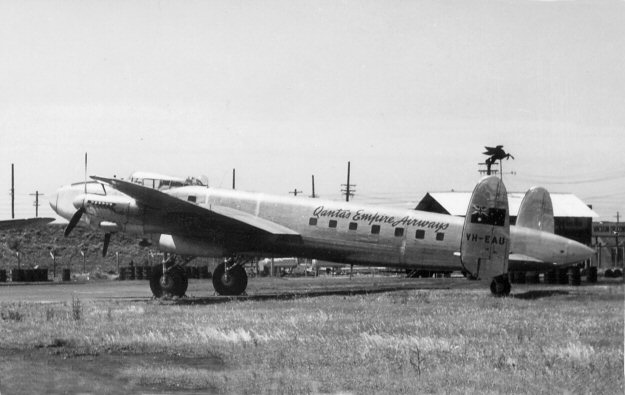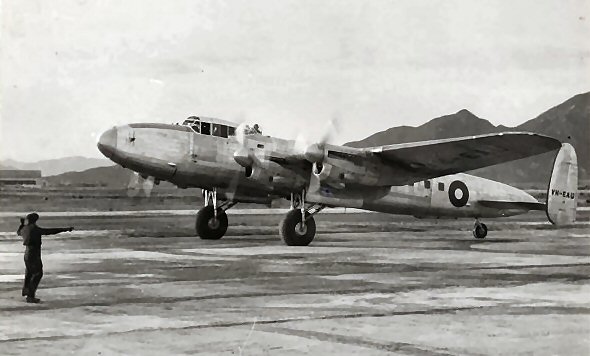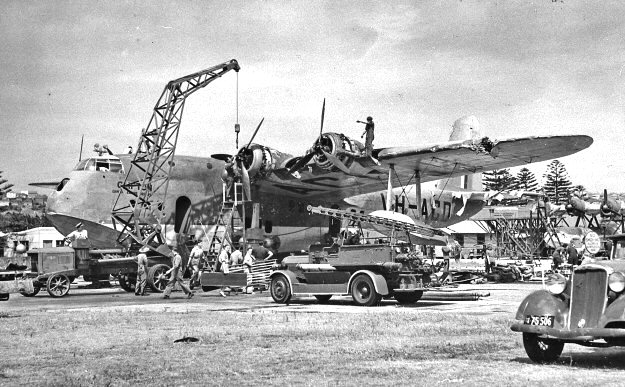Avro Lancastrian VH-EAU
Sun Dec 15, 2013 6:21 am
Avro Lancastrian VH-EAU Bofu Japan 1948






Re: Avro Lancastrian VH-EAU
Sun Dec 15, 2013 6:47 am
Interesting that it appears to be a Qantas aircraft with RAAF markings!!
Re: Avro Lancastrian VH-EAU
Mon Dec 16, 2013 3:48 am
Cool! My dad was at Bofu that year - I'll ask him if he saw it.
Re: Avro Lancastrian VH-EAU
Mon Dec 16, 2013 6:18 am
My Dad was in the BCOF at Bofu and I'm pretty sure he flew in this a/c travelling there and that I have his Qantas "King Neptune" certificate from the flight, I will look for it at the end of the week and confirm.
Regards
Mark Pilkington
Regards
Mark Pilkington
Re: Avro Lancastrian VH-EAU
Mon Dec 16, 2013 2:58 pm
And here's my dad's photo of Bofu in '48; note the P-61s:


Re: Avro Lancastrian VH-EAU
Mon Dec 16, 2013 5:45 pm
Neat stuff. Are there any other pictures around of Qantas birds wearing RAAF markings?
Re: Avro Lancastrian VH-EAU
Fri Dec 20, 2013 2:30 am
Invader26 wrote:Neat stuff. Are there any other pictures around of Qantas birds wearing RAAF markings?

Re: Avro Lancastrian VH-EAU
Fri Dec 20, 2013 4:47 am
Checked with my dad; the only Lancaster he saw (from a distance) was at Itami. He said he mostly remembered the sound those four Merlins made. He also said Bofu was pretty much a primitive backwater base; we ended up with it after the New Zealanders didn't want it any more.
Re: Avro Lancastrian VH-EAU
Sat Dec 21, 2013 1:22 am
Mark_Pilkington wrote:My Dad was in the BCOF at Bofu and I'm pretty sure he flew in this a/c travelling there and that I have his Qantas "King Neptune" certificate from the flight, I will look for it at the end of the week and confirm.
Regards
Mark Pilkington
Here is a digital photo of my Dad's "King Neptune" certificate, issued by QANTAS to members of the "Order of Equatorial Air Voyagers" and arising from Dad's flight returning from Japan to Australia on 9th March 1948 on VH-EAS (QANTAS Lancastrian) as a member of BCOF Japan, the certificate notes they crossed the Equator at 0530 GMT.

Obviously the crossing of Equators back in those days was still considered a novelty - smiles.
Here are some other photos of EAU from Eddie Coates Collection.
http://www.edcoatescollection.com/ac1/a ... H-EAU.html

This shot was definitely at Mascot, circa 1950. VH-EAU was ex G-AGLZ, VF167 and PD160.
It was withdrawn from use in 1952. The Geoff Goodall collection shot below shows it in service earlier either arriving or departing Mascot, probably in 1948, while the image at the foot of the page shows it on its first scheduled service in 1947, still with SEAC roundels and no (apparent) QANTAS titling.

The last photo is also on the National Library of Australia collection captioned "First regular flight of new Lancastrian service, VH-EAU, lands at Bofu, December 1947"
The earlier photos from CDF are reproduced on the State Library of Victoria Collection as being from the Argus Newspaper, and are simply captioned as being at BOFU @1948.
Regards
Mark Pilkington
Last edited by Mark_Pilkington on Sat Dec 21, 2013 3:50 am, edited 1 time in total.
Re: Avro Lancastrian VH-EAU
Sat Dec 21, 2013 2:02 am
So did VH-EAU ever go to Itami as well, or just Bofu? Would be cool to nail down whether this is the one my dad encountered. Were there many Lancasters/Lancastrians flying in and out of Japan by then?
Re: Avro Lancastrian VH-EAU
Sat Dec 21, 2013 2:03 am
Invader26 wrote:Neat stuff. Are there any other pictures around of Qantas birds wearing RAAF markings?
Again from the Eddie Coates Collection


From adf-serials.com.au
12/03/1942 G-AFPZ Clifton leased from BOAC to RAAF, .
14/03/1942 With 41 Sqn Coded DB-B.
Allotted to 33 Sqn,.
26/06/43 Released from RAAF service and bought by QEA, registered then as VH-ACD (named HUSSEY and ASHLEY).
18/01/44 Lost during a training landing accident at Rose Bay, Sydney.
Brought ashore, damaged now by salt water, was converted to components.
The five Double Sun-rise PBY-5 Catalina's operated by Qantas during WW2 carried RAF markings and I think BOAC rather than Qantas titles.
regards
Mark Pilkington
Re: Avro Lancastrian VH-EAU
Sat Dec 21, 2013 2:16 am
Chris Brame wrote:So did VH-EAU ever go to Itami as well, or just Bofu? Would be cool to nail down whether this is the one my dad encountered. Were there many Lancasters/Lancastrians flying in and out of Japan by then?
Qantas operated 4 Lancastrians with at least 2 carrying SEAC markings most likely to allow operations into Japan, but of course there may well have been UK based Lancastrians also operating into Japan as well.
Of course once in Japan, they could well have been used to transfer people/mail/goods from base to base before the return trip to Australia or the UK.
My Dad also had a picture of a RAAF Mustang taken at BOFU, 77 Sqn Mustangs represented the RAAF in BCOF and later participated in the Korean War before it re-equipped with Meteors .
http://www.awm.gov.au/atwar/bcof/
Participation in the British Commonwealth Occupation Force (BCOF) marked the first time that Australians were involved in the military occupation of a sovereign nation which it had defeated in war. BCOF participation in the Allied occupation force was announced on 31 January 1946, though planning and negotiations had been in progress since the end of the war. The main body of Australian troops arrived in Japan on 21 February.
The entire BCOF force totalled 45,000, from Britain, India, New Zealand, and Australia. About 16,000 Australians served in BCOF, including an infantry contingent of 4,700, base units consisting of 5,300, an air force wing of 2,200, and 130 from the Australian General Hospital. The Royal Australian Navy (RAN) also had a presence in the region as part of the British Pacific Fleet. For two-thirds of the period of occupation the Commonwealth was represented solely by Australians, and throughout its existence BCOF was always commanded by an Australian officer.
The BCOF area of responsibility was the western prefectures of Shimani, Yamaguchi, Tottori, Okayama, Hiroshima, and Shikoku Island. BCOF headquarters were located at Kure, the army was encamped at Hiro, the RAAF at Iwakuni, and the naval shore establishment at the former Japanese naval base at Kure. At the peak of its involvement the Australian component of BCOF was responsible for over twenty million Japanese citizens and 57,000 sqaure kilometres of country. Adjacent to the area of Australian responsibility were prefectures occupied by the 2 New Zealand EF (Japan), the British and Indian Division (Brindiv), and further away the US 8th Army.
The main Australian occupation component was the 34th Infantry Brigade, which arrived in early 1946 and was made up of the 65th, 66th, and 67th Battalions. The RAN ships that served were HMAS Australia, HMAS Hobart, HMAS Shropshire, and the destroyers HMAS Arunta, Bataan, Culgoa, Murchison, Shoalhaven, Quadrant, and Quiberon. Landing Ships Infantry Manoora, Westralia, and Kanimbla were used for transport.
The Royal Australian Air Force (RAAF) component was stationed at Bofu, in Yamaguchi Prefecture. The RAAF squadrons which served were Nos 76, 77, and 82, all flying Mustangs. The airforce component of BCOF was known as BCAIR. By 1950 only one Australian squadron, No. 77, remained in Japan.
By early 1947 BCOF had begun to decline and, by the end of 1948, was composed entirely of Australians. The force was dismantled in 1952, as responsibilities in Japan were handed over to the British Commonwealth Forces Korea. Some personnel stayed on to serve in the Korean War. Members of No. 77 Squadron, for example, had their "going home" celebrations interrupted by the news they were to be sent immediately to Korea. BCOF ceased to exist on 28 April 1952, when the Japanese Peace Treaty came into effect.
Australia's role in BCOF
The primary objective of BCOF was to enforce the terms of the unconditional surrender that had ended the war the previous September. The task of exercising military government over Japan was the responsibility of the United States forces. BCOF was required to maintain military control and to supervise the demilitarisation and disposal of the remnants of Japan's war-making capacity. To this end, Australian Army and RAAF personnel were involved in locating and securing military stores and installations. The Intelligence Sections of the Australian battalions were given targets to investigate by BCOF Headuarters, in the form of grid references for dumps of Japanese military equipment. Warlike materials were destroyed and other equipment was either retained by BCOF or returned to the Japanese. The destruction or conversion to civilian use of military equipment was carried out by Japanese civilians under Australian supervision. Regular patrols and road reconnaissances were initiated and carried out in the Australian area of responsibility as part of BCOF's general surveillance duties.
The RAN component of BCOF was responsible for patrolling the Inland Sea, to prevent both smuggling and the illegal immigration of Koreans to Japan. It was assisted by the RAAF whose aircraft were also involved in tracking vessels suspected of smuggling or transporting illegal immigrants. RAAF squadrons also flew surveillance patrols over each of the prefectures in the BCOF zone in order to help locate leftover weapons and ordnance.
By the end of 1946 the task of demilitarising Japan required less effort and the role of the occupying forces was changing, with guard duties and training becoming the main focus.
regards
Mark Pilkington
Re: Avro Lancastrian VH-EAU
Sat Dec 21, 2013 1:03 pm
Is it possible that, because Japan WAS the ZoO, that until some time unspecified, any aircraft flying to, from, or within the ZoO was required to carry military markings (notice that even after the shooting stopped, no red center dot in the roundels or red fin flash) as a form of identification as F or F? And it seems to me that a Lanc in the Pacific would have confused fresh faced fighter pilots who'd never flown in the ETO and might possibly suspect it was Japanese.
P-51's in Japan for some time had huge wing/fuselage stripes on them as a 'quick reference' marking.
P-51's in Japan for some time had huge wing/fuselage stripes on them as a 'quick reference' marking.
Re: Avro Lancastrian VH-EAU
Sat Dec 21, 2013 6:28 pm
Interesting. I wasn't really aware of Lancastrians in Australia. Lots of them used by TCA of course. There is a bit of footage in this video
https://www.youtube.com/watch?v=UxW5XeIqexQ
George Lothian talks about flying them in his book "Flight Deck", a very good read about the early days. He didn't like them much -- too many engine failures and he appreciated a better anti-icing system for winter flights over the North Atlantic. He much preferred the North Star. (Great book, by the way. My dad knew George in passing, and admired him as a gentleman and a pilot's pilot.)
I happened across lots of ground taxi footage of Avro Yorks here, https://www.youtube.com/watch?v=upk6LRKY9nc a far better people-hauler.
Dave
https://www.youtube.com/watch?v=UxW5XeIqexQ
George Lothian talks about flying them in his book "Flight Deck", a very good read about the early days. He didn't like them much -- too many engine failures and he appreciated a better anti-icing system for winter flights over the North Atlantic. He much preferred the North Star. (Great book, by the way. My dad knew George in passing, and admired him as a gentleman and a pilot's pilot.)
I happened across lots of ground taxi footage of Avro Yorks here, https://www.youtube.com/watch?v=upk6LRKY9nc a far better people-hauler.
Dave